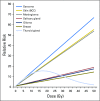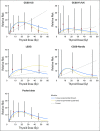Risk, Risk Factors, and Surveillance of Subsequent Malignant Neoplasms in Survivors of Childhood Cancer: A Review
- PMID: 29874133
- PMCID: PMC6075849
- DOI: 10.1200/JCO.2017.76.7764
Risk, Risk Factors, and Surveillance of Subsequent Malignant Neoplasms in Survivors of Childhood Cancer: A Review
Abstract
Subsequent malignant neoplasms (SMNs) in childhood cancer survivors cause substantial morbidity and mortality. This review summarizes recent literature on SMN epidemiology, risk factors, surveillance, and interventions. Survivors of childhood cancer experience long-term increased SMN risk compared with the general population, with a greater than twofold increased solid tumor risk extending beyond age 40 years. There is a dose-dependent increased risk for solid tumors after radiotherapy, with the highest risks for tumors occurring in or near the treatment field (eg, greater than fivefold increased risk for breast, brain, thyroid, skin, bone, and soft tissue malignancies). Alkylating and anthracycline chemotherapies increase the risk for development of several solid malignancies in addition to acute leukemia/myelodysplasia, and these risks may be modified by other patient characteristics, such as age at exposure and, potentially, inherited genetic susceptibility. Strategies for identifying survivors at risk and initiating long-term surveillance have improved and interventions are underway to improve knowledge about late-treatment effects among survivors and caregivers. Better understanding of treatment-related risk factors and genetic susceptibility holds promise for refining surveillance strategies and, ultimately, upfront cancer therapies.
Figures




References
-
- Howlader N NA, Krapcho M, Miller D, et al. (eds): SEER cancer statistics review, 1975-2014. https://seer.cancer.gov/csr/1975_2014/
-
- Gatta G, Zigon G, Capocaccia R, et al. : Survival of European children and young adults with cancer diagnosed 1995-2002. Eur J Cancer 45:992-1005, 2009 - PubMed
-
- Cardous-Ubbink MC, Heinen RC, Bakker PJ, et al. : Risk of second malignancies in long-term survivors of childhood cancer. Eur J Cancer 43:351-362, 2007 - PubMed
-
- Neglia JP, Friedman DL, Yasui Y, et al. : Second malignant neoplasms in five-year survivors of childhood cancer: Childhood Cancer Survivor Study. J Natl Cancer Inst 93:618-629, 2001 - PubMed
Publication types
MeSH terms
LinkOut - more resources
Full Text Sources
Other Literature Sources
Medical

